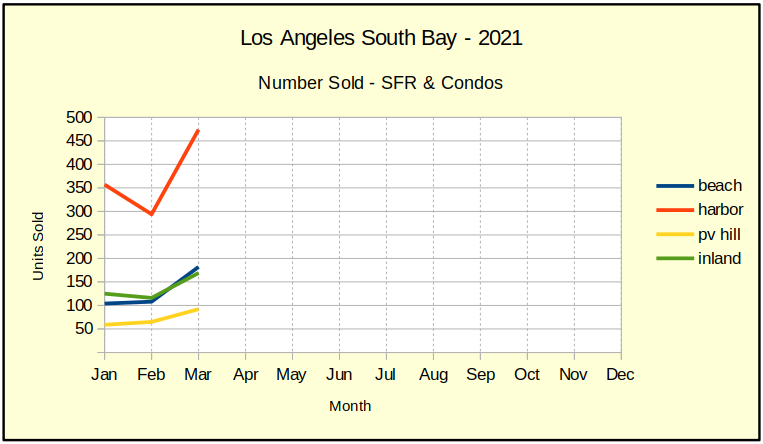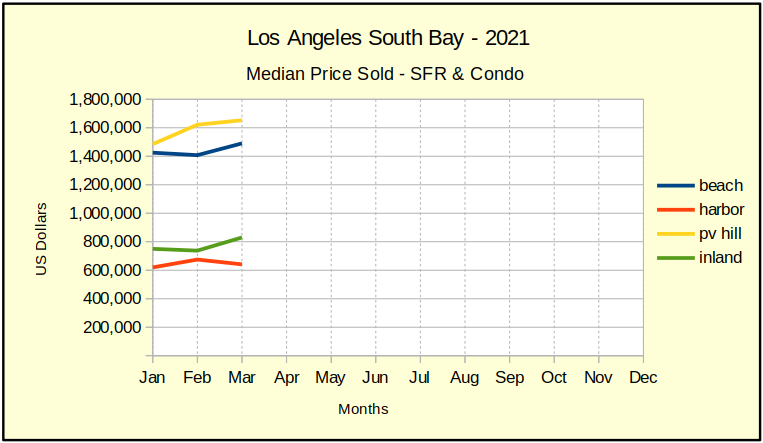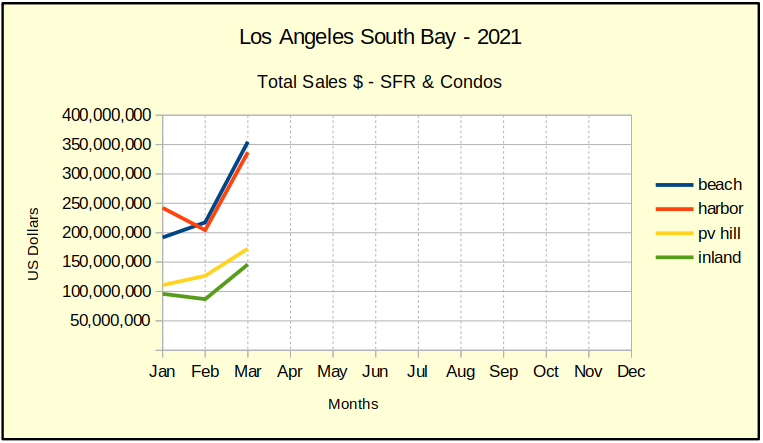From the Beach to the Harbor, from Inland to the Hill, the month of March brought an average of 57% more home sales than February! This, after February fell 10% from January, and January was down 30% from December! It’s almost as though spring’s sunlight is breaking through a crack in the Covid wall.
Last March we were seeing healthy spring growth ranging from 8% to 29% in sales volume over the prior month. By comparison this March is in a range of from 42% to 69%. That’s a tremendous jump in sales, and it corresponds nicely with the 35% to 70% annual increase in sales over March of 2020. Rarely do we see year over year sales growth above 35% in any given area, so that level of growth across the South Bay is a strong indicator that we are coming out of the erratic market of the past year.
We need to remember that home sales recorded in March of last year were transactions initiated in February for a Close of Escrow 30 days later. The comparison we’re looking at is the last normal March sales, pre-pandemic, compared to the most recent March sales as we roll into vaccinations en masse. That means they were the final set of “normal” transactions before the Covid pandemic was declared. It also means comparing statistics for this April to last April won’t be terribly useful.

That spike in sales is the “pent up demand” we’ve been hearing about. Circumstances that create a need for people to relocate have continued throughout the pandemic. Simultaneously, sellers have been very reluctant to put their homes on the market and take a chance on contracting Covid-19 from a visiting buyer. Now that threat has diminished, so buyers and sellers are making up for lost time.
We anticipate continued froth in the form of increased prices and bidding wars for the balance of 2021. Gradually everyone will catch up with their real estate goals and things will settle down. There is a good chance most of the price increases will stay with us. That’s a plus for sellers, while buyers will only be hurt by the higher prices.
Prices Skyrocket with Pent-Up Demand
Switching our attention from sales volume to median value, let’s look at how prices have been changing. Year-over-year, the median price came in above last March in the range of 8% to 18%. This is stubbornly high compared to the Consumer Price Index (CPI) of 4.7% for increased housing costs in the Greater LA area during 2020. The last time annual price increases were this dramatic was just before the Great Recession.

When we look a little closer, we’re seeing some weakness in the more current sales prices. Beach and Inland areas both showed big month-to-month improvement over February of this year. The Hill had a more modest 2% increase. The single negative showing in the first quarter, Harbor prices are down -5% for March, despite rising 1% in January and another 9% in February.
As the pandemic ends, we’re seeing a lot of people trying to escape the lease trap (rental prices are going up even faster than sales prices) by taking advantage of historically low interest rates. However, rising sales prices are meeting resistance on the part of some buyers. Possibly because interest rates have starting climbing again. Possibly because the employment picture is still untenable for many.

As the chart above shows, prices for the first quarter are wobbly–a little up and a little down. The Fed is trying to stimulate financial activity to pull our nation through the pandemic by keeping the overnight bank loan rate at near zero. Meantime, the investor market is smelling money and gradually hiking mortgage rates. As the mortgage interest rate edges up, more and more potential buyers are priced out of the market. The first place this shows up is in the entry level market, which is predominately found in the Harbor and Inland areas.
Real Estate for Spring / Summer??
So what’s the forecast for the hottest selling months of the year? The pundits are split about 50/50 on whether the stimulus funding will turn this into a booming economy, or when we emerge from the pandemic, we’ll run smack into a wall of recession.

There is definitely money flowing. The Beach and the Harbor areas show the steepest growth, both adding about $135M in overall sales from February to March.
Anecdotally, there’s a significant percentage of first-time buyers who are now able to qualify for a loan, because of the interest rate. That group is looking at entry level homes throughout the area. Another set of buyers is now able to buy an additional investment property to rent out, because of the interest rate. First time buyers and investors are looking at the same properties and bidding against each other.
As mentioned earlier, April 2020 is when the pandemic blew holes in the economy. Whatever April brings this year, we’ll have to find a new way of looking at it. April and May last year plummeted with drops ranging from 25% to over 50%. Comparisons to last year could be interesting, but most likely uninformative.
Main photo by Barthelemy de Mazenod on Unsplash
